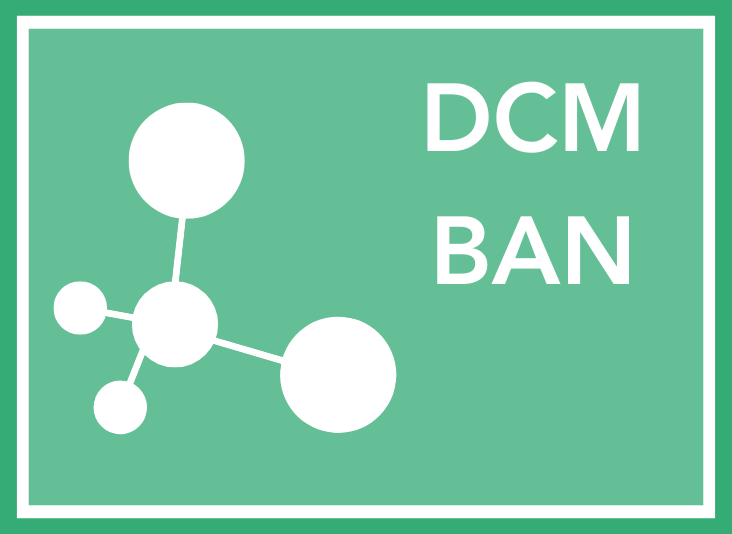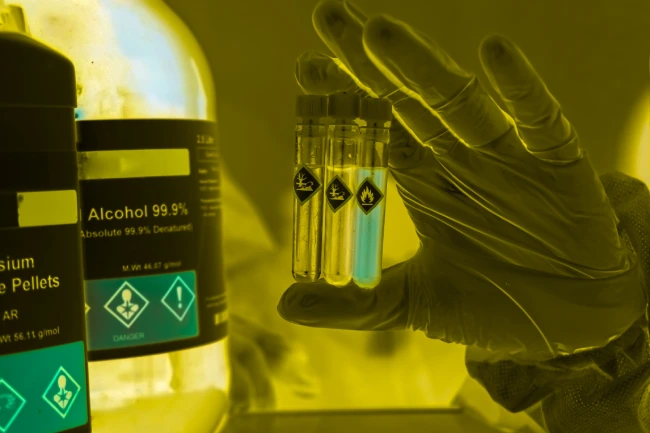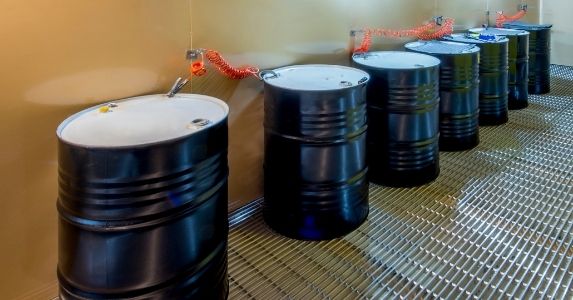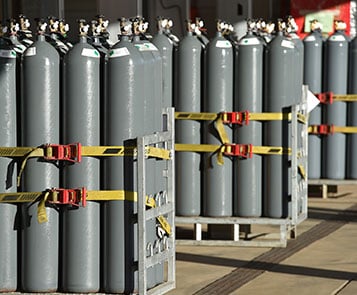EPA Methylene Chloride Ban: What You Need To Know
Industries across the board are facing a major federal methylene chloride ban. This ban could cause them operational disruptions, lost time and effort, and noncompliance. Planning for compliance now, as the full details of the DCM ban trickle out, will allow operations to weather any regulatory storm.
Methylene chloride, commonly known as dichloromethane (DCM), is a widely-used chemical across industries. Studies have repeatedly shown negative health effects associated with its use, however, leading many environmental, health, and safety (EHS) industry professionals to wonder why it has yet to be banned. As of yet, the substance’s wide array of uses and many important benefits seem to have outweighed its bad effects.
The tide appears to be turning, however: The Environmental Protection Agency (EPA) has finally announced a ban on the solvent. This methylene chloride ban will ripple out to the wider community, being felt by organizations nationwide, and cause EHS compliance impacts for all. Most industrial and commercial uses for DCM are banned, but the EPA has banned all consumer uses of the chemical.
Organizations that fail to implement the terms of the EPA methylene chloride ban in a timely manner risk safety and noncompliance—which may mean citations, fines, and lost time, money, and effort in the struggle to play regulatory catch-up.
What Are Common DCM Uses?
Methylene chloride has a chemical composition that makes it a powerful and effective compound. Its many uses include, but are not limited to:
- Degreasing
- Paint removal
- Adhesives
Its powerful properties make it a very commonly-used laboratory solvent, especially in pharmaceutical and university labs. In these settings, scientists favor DCM because it is a polar aprotic solvent with a low boiling point—making it ideal for extraction, synthesis, and purification processes.
What Are Some Negative Methylene Chloride Impacts?
Methylene chloride exposure most commonly occurs through inhalation or skin absorption. Without adequate personal protective equipment (PPE), EHS training, and biosafety precautions, this could mean health risks such as lung, brain, heart, and liver damage or even cancer.
Without all the correct safety measures in place, staff can be exposed to DCM—and its relevant hazards. Whether from accidents or from repeated operational use, workers may face negative health impacts from a variety of sources.
Is Methylene Chloride Bad For You?
Studies have repeatedly shown that methylene chloride use has both acute and chronic effects on those who directly interact with it—but the substance can impact anyone even simply passing through the general area in which the chemical is being used. These adverse effects can mean damage to the central nervous system, heart, and liver. On top of this, DCM exposure increases the risk of cancer in users and consumers. So it's easy to conclude that methylene chloride is bad for you—which is why there is a federal methylene chloride ban.
 How long do DCM fumes last?
How long do DCM fumes last?
The length of time organic DCM vapors linger in the air is dependent on a variety of factors, including the initial volume, the room’s air changes, usage of local exhaust ventilation, and operation of fume hoods, as well as temperature, humidity, and other environmental conditions. The only way to get a clear understanding of exposure is to conduct industrial hygiene services—specifically monitoring.
 How can I shorten the length of time DCM fumes stick around?
How can I shorten the length of time DCM fumes stick around?
The length of time organic DCM vapors linger in the air is dependent on a variety of factors. A task-by-task risk assessment is the best method to identify facility-specific control methods.
Road to a Federal Methylene Chloride Ban
Given these risks and because of how common these chemicals are, an EPA methylene chlorine ban has been a long time coming. In 2020, the EPA conducted a risk evaluation in accordance with the Toxic Substance Control Act (TSCA).
In 2022, the final risk evaluation was released—announcing that the administration found unreasonable risk of injury to human health. On May 8, 2024, the EPA issued the Methylene Chloride Regulation under TSCA, and on July 8, 2024, the Final Rule on the Regulation of Methylene Chloride, also known as the Methylene Chloride Rule, went into effect.
The EPA has set a target date of May 8, 2029, five years after publication of the final rule, to transition to full compliance. Over the next few years, organizations across industries must phase out their use of DCM. This will involve:
- Close review of the Methylene Chloride Rule and strict adherence to its guidelines
- Solvent disposal that is safe for both workers and the environment
- Finding new processes, with chemical alternatives, that can replicate methylene chloride’s effects
- Establishing safe storage areas to hold DCM containers slated for disposal
So, is methylene chloride banned in the US? Yes, almost entirely—and there are strict compliance requirements if an organization meets an exception and is still able to use DCM in their facilities.
Why is DCM banned?
DCM is widely and commonly used in educational, pharmaceutical, and manufacturing, and other facilities because the chemical properties of the solvent make it efficient for many common lab processes. DCM exposure, however, even in the most minor quantities, has been repeatedly proven to cause acute and chronic human health impacts. The combination of these two factors are why DCM is banned.
Are there any times that DCM may still be used?
There are many industrial and commercial DCM uses that the methylene chloride ban does not prohibit, such as domestic manufacturing, processing as a reactant, and use as a laboratory chemical, among others. These conditions of use, however, will now require a Workplace Chemical Protection Program (WCPP) under the DCM ban rule.
How Will The DCM Ban Impact My Organization?
Any organization that creates, uses, or disposes of DCM must prepare for compliance in all of their facilities. Although incomplete, the above compliance checklist will be difficult for managers to tick down without wide organizational commitment and resources. To assist with the transition to ban compliance, the EPA has created a Workplace Chemical Protection Program (WCPP) to mitigate the various risks organizations face while storing, handling, and disposing of methylene chloride. The WCPP will include requirements for:
- Occupational Exposure Limits (OELs)
- Monitoring parameters
- Exposure Control Plans (ECPs)
- Identification of regulated areas
- Respiratory protection and PPE
- Training
- Recordkeeping
By early May 2029, the use of methylene chloride across various industries will be prohibited. The precise deadlines for regulatory compliance may vary slightly from organization to organization, based on the condition of DCM use. Ultimately, however, all affected organizations must comply. This will also include mandatory employee DCM exposure monitoring with an initial deadline of May 5, 2025.
Various timelines for different classes of methylene chloride users can be found in the EPA’s “A Guide to Complying with the 2024 Methylene Chloride Regulation Under the Toxic Substances Control Act (TSCA),” but this document can be long and complex.
There are also some methylene chloride ban exemptions, outlined in TSCA 40 CFR 751.10. In short, the exemption applies to organizations that use amounts of methylene chloride under the de minimis threshold of 0.1% by weight.
What precautions do I need to take if I still use DCM in my facility?
Because of the methylene chloride ban, you must ensure employee exposure is kept below the EPA existing chemical exposure limit (ECEL) of 2 ppm and EPA short term exposure limit (EPA STEL) of 16 ppm for DCM. Furthermore, you will need to implement a Workplace Chemical Protection Program (WCPP), which includes requirements for air monitoring, area demarcation, training, and a written exposure control plan.
What PPE is needed to work with DCM?
Necessary PPM while working with DCM can vary considerably depending on employee DCM exposure. Air-purifying respirators may be required, or chemical-resistant gloves and eye protection may be sufficient for your operation. Industrial hygiene services like air monitoring can help measure employee DCM exposure; this, along with detailed risk assessments, will help you determine the most appropriate PPE at your facility.
What PPE level is needed to work with DCM?
The PPE required to work with DCM can vary based on the duration and quantity of chemical use, tasks involved with the use, and most importantly, the controls already in place. In most cases, gloves and eye protection (Level D PPE) are the bare minimum of what is needed. Whether additional PPE is needed, such as respiratory protection (Level C PPE), depends on the hazards associated with your specific operation.
When working with DCM, it is important to remember the hierarchy of controls—elimination, substitution, engineering, and administrative controls should be used first and foremost for safety and compliance, and PPE is the last line of protection and should not be used as the only safety control if possible.
What are the safety precautions for dichloromethane?
For laboratory work, employee DCM exposure must be kept below the EPA existing chemical exposure limit (ECEL) of 2 ppm and EPA short term exposure limit (EPA STEL) of 16 ppm. Furthermore, laboratories will need to implement a Workplace Chemical Protection Program, which includes requirements for air monitoring, area demarcation, training, and a written exposure control plan.
Can overexposure to DCM be monitored?
Yes! There are industry-standard sampling methods and analytical laboratories that can provide detailed reports on employee DCM exposure, as well as recommendations on how to lower those DCM exposures. This work is conducted by industrial hygienists and other trained safety professionals. This is the first step toward methylene chloride ban compliance.
What are the methods of measuring DCM exposure?
Methylene chloride is monitored by employee breathing zone samples. A sampling device is affixed to an employee while they conduct their tasks over a measured amount of time. Based on the volume of air sampled and the contaminant detected by laboratory analysis, an average exposure concentration can be calculated. This work is conducted by industrial hygienists and other trained safety professionals specifically trained in these processes.
What is the limit for DCM exposure?
Employee exposure must be kept below the EPA existing chemical exposure limit (ECEL) of 2 ppm as an 8-hour time-weighted average. It must also be kept below the EPA short term exposure limit (EPA STEL) of 16 ppm in a 15-minute period.
What is the OSHA exposure limit for DCM?
The methylene chloride ban and associated new EPA limits are substantially lower than the OSHA permissible exposure limit (PEL) of 25 ppm and the STEL of 125 ppm, meaning that new controls may be warranted to lower exposure under the new dichloromethane ban.
What is the best DCM exposure control method?
Completely eliminating or substituting the usage of DCM at your facility is by far the best exposure control method. If you must still work with DCM, even under the methylene chloride ban, conducting work within an engineering control (e.g., a fume hood), limiting quantities and exposure time, or providing respiratory protection are all examples of control methods that may be appropriate to limit DCM exposure.
Will we need to perform air monitoring everywhere methylene chloride is used?
Yes. Under the new methylene chloride ban, representative breathing zone samples are required to be taken for every potentially exposed person in the facility.
What is a DCM exposure control plan?
A DCM exposure control plan is a required written plan that describes, among many things, how DCM controls were identified, how inhalation exposures are reduced below existing chemical exposure limit (ECEL), a description of regulated areas and job tasks, and procedures related to new tasks.
How can I begin to implement a DCM control plan?
The first step to implementing a DCM exposure control plan is to understand employee DCM exposure to begin with. This requires a risk assessment of DCM usage within your facility followed by representative breathing zone monitoring. Based on these results, the exposure control plan can be developed.
How Can I Comply With Methylene Chloride Ban Regulations?
With widespread implications, various exemptions, long and complex guidance documents, and the demand for innovative solutions to replacing worksite DCM, it will be hard even for managers with robust EHS and chemical inventory management and related resources to comply. The EPA has banned all consumer uses of methylene chloride, as well as most industrial or commercial uses. There are strict rules in place that help regulate the commercial and industrial uses that are still allowed—including an employee DCM exposure monitoring requirement.
If you’re unsure of how to comply with the Final Rule on the Regulation of Methylene Chloride, contact Triumvirate Environmental today. Our dedicated team can help to implement the WCPP in your workplace, advise you on best practices and industry changes, perform industrial hygiene services like air monitoring, and ultimately keep you and your team safe and compliant.






